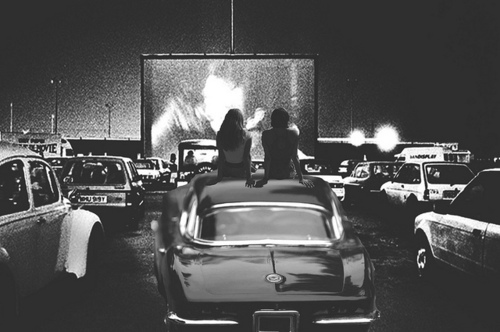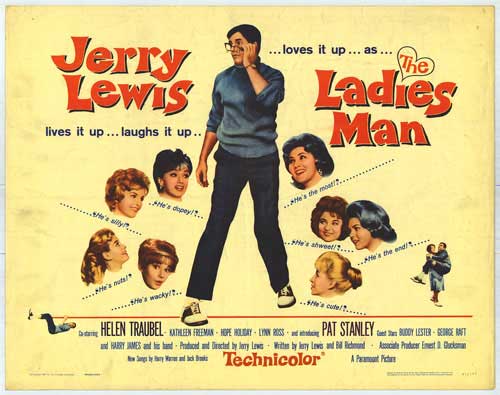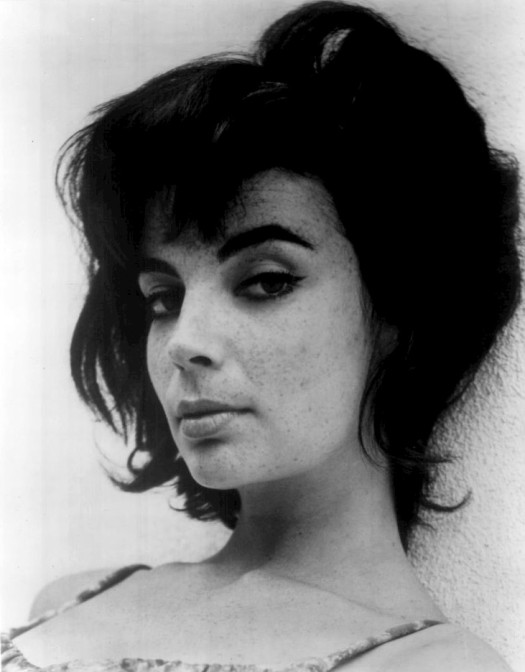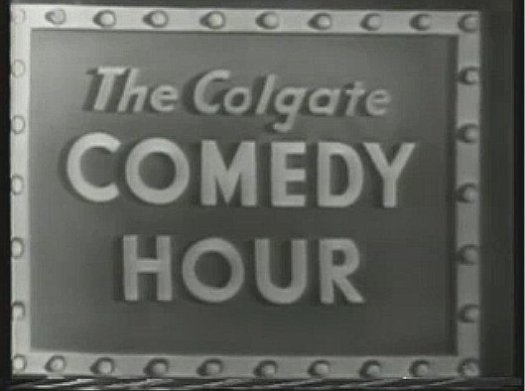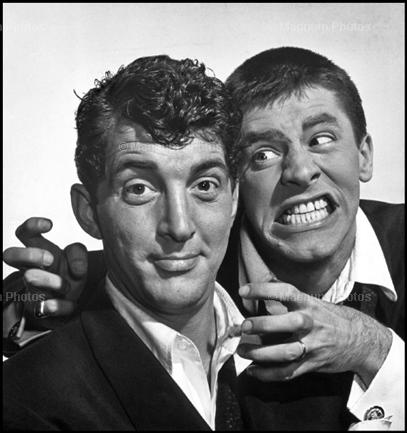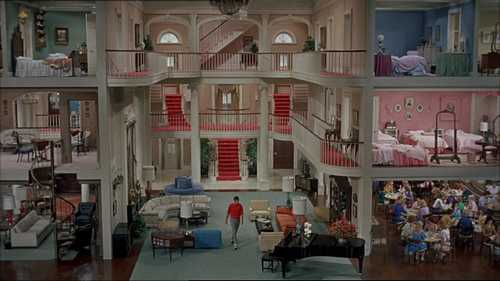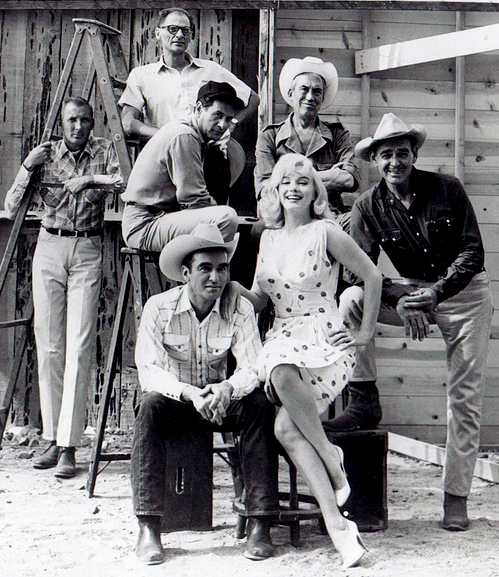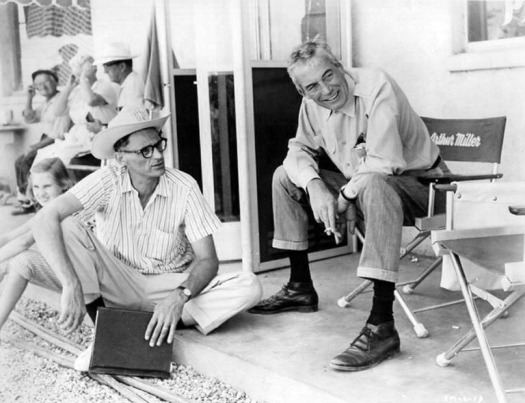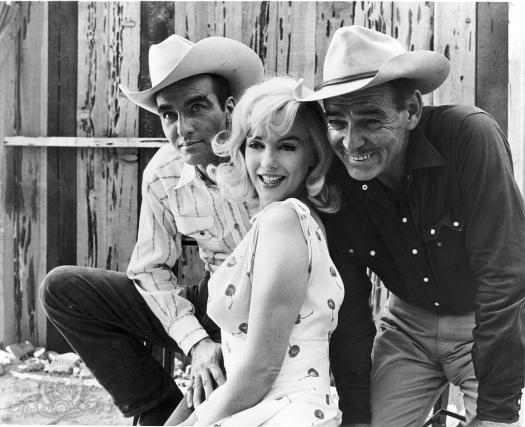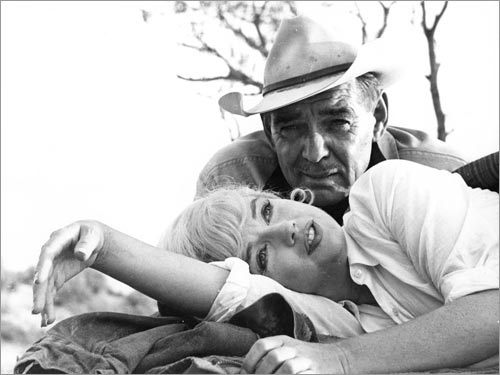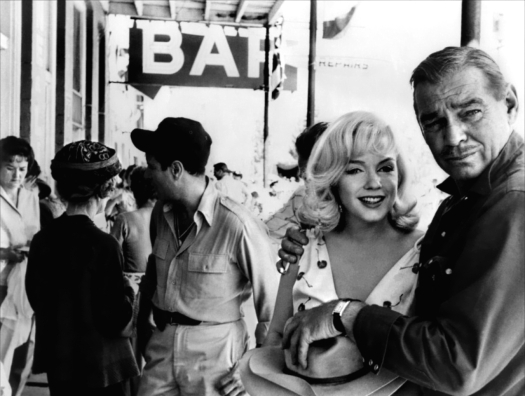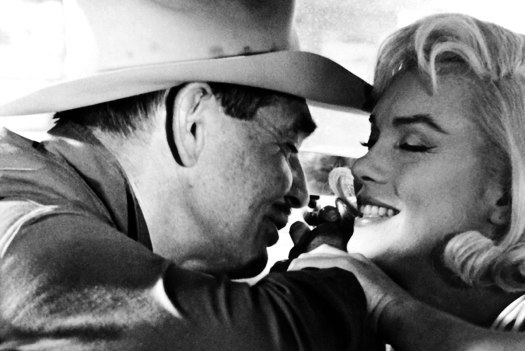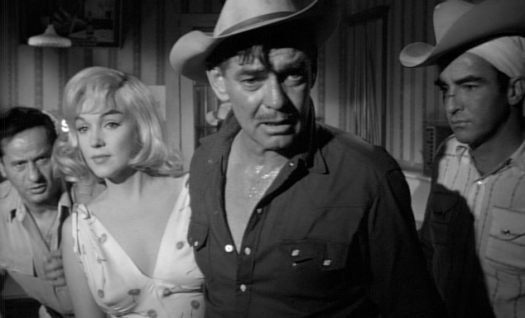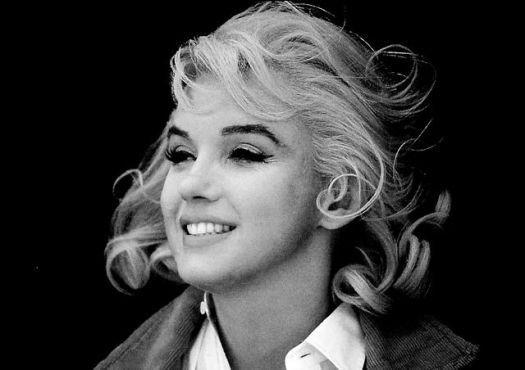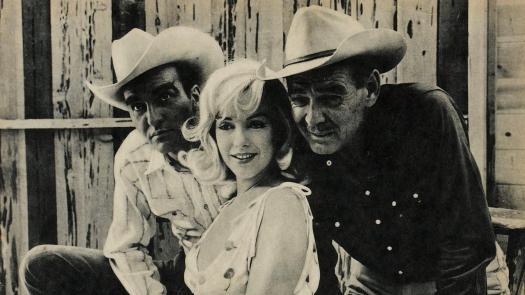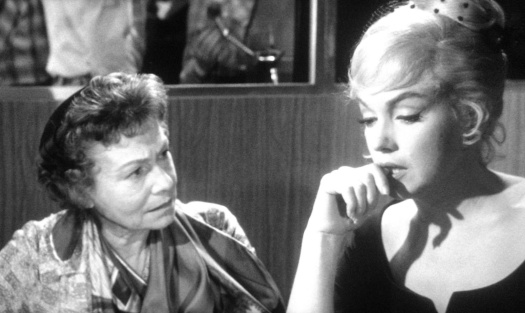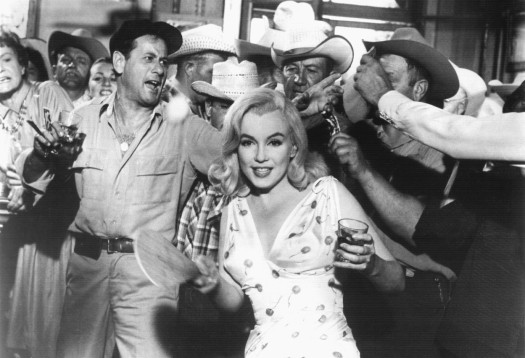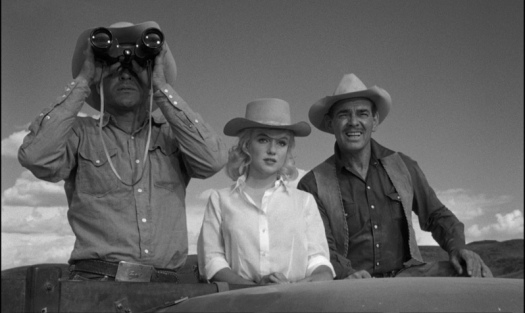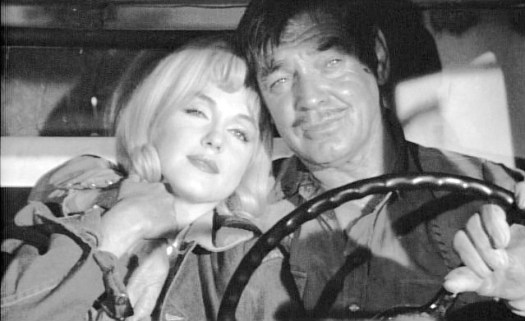His & Hers Drive-In Double Feature :: 1961 :: The Ladies Man and The Misfits
This batch of drive-in double feature choices could not be anymore different if we tried. We start our ode to 1961 with one of Jerry Lewis’ solo adventures, in directing, producing and acting, with a slap-stick heavy and plot light film, The Ladies Man and then end off our night at the movies with an epic tale of desolation and desperate love, with The Misfits, starring a trio of outstanding actors, Clark Gable, Marilyn Monroe and Montgomery Clift, and directed by the incomparable John Huston. This is the first time (so far) that the movies chosen were so far off from each other that it almost feels awkward to have them in the same review. But, perhaps that is part of what makes this experiment in movies and writing so interesting, the differences between our choices, and the varying degrees of style and substance that goes on in the world of film over the years.
So, get ready, grab some coffee, or a shot of whiskey, and set yourself down to get a dose of two films that we would both agree should never be seen together, and let us know in the comments below what you think of the films, share with us what you would choose from the films of 1961, and also feel free to offer some suggestions for our next installment, a double-feature of movies from 1962.
The Ladies Man (1961)
Trailer
Brief history:
In The Ladies Man, Jerry Lewis plays Herbert H. Heebert, a young man who loses his girlfriend, swears off romance, and then takes a job at a women-only boarding house, run by Helen Wellenmellen (played by Helen Traubel). Although most of the women treat him like a servant, Fay (played by Pat Stanley) helps him with his fear of women, including Lillian Briggs, the blonde bombshell “Queen of Rock & Roll“, who made her Hollywood acting debut in the film.
The film boasts a main set that is a four story doll house-like interior of a mansion turned boarding house with a central courtyard allowing crane shots spanning floors. At $350,000, it was the most expensive set for a family comedy to date. The set took eight months to build.
During this production Jerry Lewis attached a small video camera to the side of his 35mm camera, in effect, pioneering the “video assist” system that is standard on just about every feature film today.
Karyn Kupcinet
Karyn Kupcinet’s first and only movie appearance. She’s the snooty girl in the red dress who infuriates Herbert by calling him “Herby“. She was murdered two years later, a crime that remains unsolved.
During one of the first scenes where Herbert is on the bus bench, a part of the poster for Cinderfella, a previous Jerry Lewis film, can be seen just to the left of the drug store behind him in the alley (noticed by Charles immediately in the scene).
During a 2008 interview, Mel Brooks noted that he wrote the original script for this movie, but since most of his work was excised from the final version asked that his name be removed from the credits. A handful of his comedy bits remain in the film, including a scene of Jerry Lewis dusting a trophy case and releasing the live butterflies within, and a scene in which Lewis goes through a car wash in a convertible with the top down.
His take:
One has to wonder if this had been a different film if they had stuck to the original Mel Brooks’ script. It is hard to tell that Jerry had done five other feature films on his own before this one, because the entire time watching this film you could tell that he needs a “straight man” to play off of. You’d think it would be hard to screw up a “at the time” original concept of one guy in a house full of women, yet Jerry found a way. Above and beyond no coherent story line (you get more background information regarding story and plot from the trailer than you do the entire film), but the entire movie seems like one “look at what I can do” after another.
Somehow I feel that this film could have been one episode of the The Colgate Comedy Hour, only that would have been funnier because Dean would’ve been there. Is it any wonder that some of the funnier bits involved playing off of a “straight man” or that the gags that remained from Brooks’ original script.
Fortunately, in later films, Jerry seemed to realize he needed that “straight man” to play off of, even if that “straight man” was himself (i.e. The Nutty Professor, The Family Jewels).
I find myself without funny commentary due to the fact that there was really not much “funny” to this film. It is easy to see why the French see him as a comedy genius.
3 B rating (1 point given for Boobs, Beasts and Blood): 2 B’s – 1 B for breasts, ‘cos there was a ton of them, and 1 B for beasts, half for “Baby“, and half for this script. There was no blood here.
Her Take:
I suppose I should premise my reaction and review of this film by saying I have never been a fan of Jerry Lewis. That kind of over-the-top reliance on pratfalls and screwed up face slapstick has never held my attention for very long, especially not when it replaces both character and plot. From nearly the start of the film (I did enjoy the domino effect opening scene through the very recognizable Paramount Studios’ back lot) to the end I found myself cringing at the trips and falls, cross-eyed contrived crazy, and flimsy characterizations that the movie was made of. It even had one of my least favorite gags in it, the intentional unattractive gender-swapped character played by the leading man (see Jerry as his own Mother, and oh my, what Freud would have done with that).
Though the film was initially written by Mel Brooks’ (can we see that version instead, please?), it was Jerry who was credited for the writing, directing and producing of the film, as well as starring in it. Though I will give him credit for some interesting direction, the film as a whole just felt like a masturbatory ego explosion. This felt like strung together skits that main goal was to present our “star” and all his many “talents”, abandoning all other characters and potential story lines in the dust, or editing room floor.
The set though, oh my stars, the set was pretty damn incredible. As a young girl I was a lover of dollhouses, having two of my own, and frequenting many miniatures and doll house museums and showcases that I could find. The hotel set looked like a giant dollhouse, with no existing “fourth wall“, and camera shots that successfully caught each floor and room, and the action within, brilliantly. The set was the one thing I did really enjoy.
The plot though, it was near non-existent. It was not until I hit play on the trailer that I realized that it was an all-girl’s Hollywood hotel in which Jerry’s Herbert was hired to work in. By the first reaction of the cook and housekeeper Katie when Herbert asked what the place was I was certain this would end up a brothel, or some home for recent divorcees or singletons looking to score a husband. None of that was made clear though, and any actual moments of real between characters were short-lived and forgotten about quickly. When the film was over it left me with no conclusion, nor understanding, of what I had just watched; instead I was just left annoyed at the constant “Jerry Lewis screams and yells“.
Her Rating: Out of 5 stars: I give this film 1 star, and it is for the set and nothing at all else.
The Misfits (1961)
Trailer
Brief history:
The Misfits is a 1961 American drama film with a screenplay by Arthur Miller which was directed by John Huston. The picture stars Clark Gable, Marilyn Monroe, and Montgomery Clift, with a supporting cast including Thelma Ritter and Eli Wallach. The Misfits was the final film appearance for both Gable and Monroe, and the third-to-last for Clift. The plot centers on a recently divorced woman (Monroe) and her time spent with a cowboy (Gable), a widower (Wallach) and rodeo wanderer (Clift) in the Western Nevada desert in the 1960’s.
The story was orginally written as a short story by Arthur Miller while awaiting his own divorce in Reno prior to marrying Marilyn Monroe.
The making of The Misfits was troublesome on several accounts, not the least of which were the 108 degree (42°C) heat of the northern Nevada desert and the breakdown of Monroe’s marriage to writer Arthur Miller. Miller revised the script throughout the shoot as the concepts of the film developed.
Director Huston gambled and drank and occasionally fell asleep on the set. The production company had to cover some of his gambling losses. In a documentary about the making of The Misfits, Eli Wallach told a story of Huston’s directing a scene in which Wallach was at a bar with Gable. Huston told him that the most intoxicated he had ever been was the day before, even though he had seemed sober.
John Huston pocketed $250 by casting himself as an extra in the blackjack scene. Huston’s lover, Marietta Peabody Tree, had an uncredited part in the film.
Monroe was sinking further into alcohol and prescription drug abuse; according to Huston in a 1981 retrospective interview, he was “absolutely certain that she was doomed” while working on the film: “There was evidence right before me every day. She was incapable of rescuing herself or of being rescued by anyone else. And it affected her work. We had to stop the picture while she went to a hospital for two weeks.” Huston shut down production in August 1960 to send Monroe to a hospital for detox. Close-ups after her release were shot using soft focus. Monroe was nearly always late to the set, sometimes not showing up at all. She spent her nights learning lines with drama coach Paula Strasberg.
A doctor was on call 24 hours a day for both Marilyn Monroe and Montgomery Clift during the filming because both were experiencing health problems with alcohol and medical stimulants.
Marilyn Monroe’s confidant and masseur, Ralph Roberts, was cast as an ambulance attendant in the film’s rodeo scene.
Clark Gable insisted on doing his own stunts, including being dragged about 400 feet (120 m) across the dry lake bed at more than 30 miles per hour (48 km/h).
When Montgomery Clift was filming one of his rodeo stunts, his shirt was ripped. They decided to keep filming and the torn shirt can be seen in several shots.
1930’s Western actor Rex Bell (who was married to Clara Bow) made his final film appearance in a brief cameo as a cowboy. Bell was Lieutenant Governor of Nevada at the time.
Thomas B. Allen was assigned to create drawings of the film as it was made. Magnum Photos had staff photographers, including Inge Morath and Eve Arnold, assigned to document the making of The Misfits. Morath married Miller, Monroe’s former husband, soon after the film was released.
During production, the cast’s principals stayed at the Mapes Hotel in Reno. Film locations included the Washoe County Court House on Virginia Street and Quail Canyon, near Pyramid Lake. The bar scene wherein Monroe plays paddle ball and the rodeo scenes were filmed in Dayton, Nevada, northeast of Carson City. The climax of the film takes place during wrangling scenes on a Nevada dry lake 12 miles east of Dayton, near Stagecoach. The area today is known as “Misfits Flat“.
Despite on-set difficulties, Gable, Monroe, and Clift delivered performances that modern critics consider superb. Many critics regard Gable’s performance to be his finest, and Gable, after seeing the rough cuts, agreed. Monroe received the 1961 Golden Globe Award as “World Film Favorite” in March 1962, five months before her death. Directors Guild of America nominated Huston as best director.
There were high expectations, given the star power of writer, director and actors. Producer Frank E. Taylor had heralded The Misfits as “the ultimate motion picture” before its release. The Misfits was met with mixed reviews and failed to meet expectations at the box office, and has been historically referred to as a “box office disaster” of its day.
Despite being shot in black and white, the final cost was about $4 million. Its original domestic gross was just over its estimated budget of $4,000,000, making $4,100,000 in its initial USA release.
On the last day of filming, Clark Gable said regarding Marilyn Monroe, “Christ, I’m glad this picture’s finished. She damn near gave me a heart attack.” Gable suffered a heart attack two days after filming ended and died ten days later, November 16, 1960.
Monroe and Clift attended the premiere in New York in February 1961 while Monroe was on pass from a psychiatric hospital; she later said that she hated the film and herself in it. Within a year and a half, she was dead of an apparent drug overdose. The Misfits was the last completed film for both Monroe and Gable, her childhood screen idol. Marilyn had, as an abandoned child, often claimed that Gable was her father.
This movie was on television on the night Montgomery Clift died. His live-in personal secretary, Lorenzo James, asked Clift if he wanted to watch it. “Absolutely not” was Clift’s reply, the last words that he spoke to anyone. He was found dead the next morning, having suffered a heart attack during the night.
Horror punk band The Misfits named themselves after this movie.
His take:
I want to start off by saying no matter what Hollywood tries to force feed us Mariyn Monroe is one of my top three “hottest fillies” in film ever. That being said, this movie was so depressing. You would think John Huston had never heard the concept of comedic relief. Its amazing how you can have so many stars in one film and not really like a single one of their characters personalities.
You’ve got a story of four broken people finding each other in the vast expanses of Reno, Nevada, a city in a state filled with broken people, yet you see very little about what has caused them to be broken. You’ve got one guy with survivor guilt, another guy with absentee Father guilt, another guy with Daddy-issues, all of these guys cowboys, who see no problem in getting dragged behind a horse or kicked in the head by a bull and be able to just “walk it off”, yet the one problem we are allowed to look into seemingly ruin their lives.
Marilyn Monroe’s character is the only exception (no doubt due to the fact that her soon-to-be ex-husband wrote the script with her in mind), being the only character flushed out, giving us some lengthy background into why her life has taken such a wrong turn. Her character, much different than her other characters and assumed real life, she is constantly in search of acceptance, love and affection.
Filmed against a beautiful backdrop of the Nevada deserts makes me kind of homesick. This film was a fitting swan song for both Gable and Monroe, who regardless of my personal feelings of the script delivered superb performances and helped humanize character traits that they had played many times before.
3 B rating (1 point given for Boobs, Beasts and Blood): 2 B’s – 1B – 1 B for breasts, I swear to Gawd Marilyn was not wearing a bra in one of the scenes, 0 for beasts unless you could these three really dislikable men who if this film was written today may have raped her in some of these scenes for “shock value” seeing how these men behave around her, and some of the subtext throughout, and 0 for blood.
Her Take:
The Misfits is a film that I have wanted to watch for years and years, but somehow never got around to until today. I came to the movie with some history up my sleeve, and some preconceived ideas based much on biographical stories and documentaries I have seen on Marilyn Monroe, as well as my own perceptions of the three main actors, Clark Gable, Montgomery Clift and Marilyn, all favorites of mine. I did not know a great deal about the story, but I did expect starkness, rough around the edges characters, and a sadness that permeated off of any photographs I have ever seen taken on the set of the film. I expected to like the film.
My expectations were not just met, but far exceeded. This will quickly join the ranks of my favorite movies, without a doubt, and I find myself, here hours later, still partially residing in the story, and characters. It got to me on an emotional level, and some of the untold pieces I find myself mulling over, and filling in. Maybe that is half due to the writer side of me, but I do believe it is also half due to the well-crafted characters.
The movie is stark, desolate really, and full of a loneliness and desperation that transcends the characters own loneliness and desperation. The dust and desert seems to stretch out into infinity, and in all that space there are these characters clinging to each other to an almost claustrophobic degree because the alternative is being lost in all that vast space. At times I found myself questioning if the characters liked each other all that much, as they certainly clashed and clawed emotionally at one another, often competing for the closeness they craved. There was love words thrown around, but never landing and connecting in any mutual kind of way. So much of the sentiments and affections missed their intended targets and were left blowing in the dust between, or swirling into the alcohol they over-consumed.
The story begins in the city of Reno where we meet Roslyn (Marilyn Monroe) who is staying at a boarding house for soon-to-be-divorcees run by Isabelle (Thelma Ritter). Isabelle has taken a liking to Roslyn and takes on the role of counselor and friend, though the friendship seems to be based on each woman’s need for the parent/child connection. We briefly meet Roslyn’s soon-to-be ex-husband and our take away from the relationship is that Marilyn felt abandoned, a feeling that seems to both haunt and control her throughout the film, clouding her judgment and motivating her choices. It is her need to not be alone or abandoned that has her play house with Gay (Clark Gable), acting as his wife even though she tells him early on that she doesn’t feel that way about him.
Everyone we meet throughout the film seems to look to Roslyn to fulfill something they are lacking, bet it a second chance at a marriage and family, life without the shadow of guilt, or someone to see as home. They all seem to want to possess her, to love her, to make love to her, and to ultimately consumer her. What does Roslyn want? Honestly, she is not all that dissimilar. She wants to be loved, but more than that, she wants to not be alone, and she seems to be ever longing and wistful to the point of pain for some kind of simpler life. It is in these moments that I found it hard to watch Marilyn emoting in this way as Roslyn because it felt too close to Marilyn herself. The pain just shot out of every pore, and her eyes seemed sadder than I had ever seen them before. In some moments watching her was heartbreaking.
Perce (Montgomery Clift) brought light and energy to the character dynamic, though not in a way that gifted the group much levity. A friend recently mentioned to me that Montgomery Clift stole the movie, and in some ways I would have to agree. It felt near impossible to look away from him when his character was in scene, and it was his character that I often found the most open and vulnerable, yet also mysterious. Perce seemed lost in a way that differed from the rest. At times he seemed to be longing for a Father figure, and for the acceptance of other men, seeking the approval and companionship of Guido and Gay, while also trying desperately to impress them with how much pain and danger he could survive. In the scenes with Roslyn, though, he seemed to be longing for love, and for someplace to call “home“. He never tried to assert himself with Roslyn in the way that Guido and Gay did, which could be seen as the lack of confidence in his youth, though he did (albeit drunkenly) tell her he thought he loved her. He seemed the most touched, though, at the idea that she cried for him, which suggests that he was seeking a Mother figure, as well.
Clark Gable and Marilyn Monroe put in what I would say was the best performances of their career. Clark was painfully brilliant in every layer of brokenness he showed us as the aging cowboy who has realized what he has lost and left behind. Though I never did believe in the “romance” with Roslyn, I never once doubted the affection (there was always too much of a parental feel to all of it to see passion). Marilyn, in her performance, was dynamic and multi-faceted in her portrayal of Roslyn, showing the innocent naivete of a little girl at one moment, and the jaded and disillusioned adult who has been let down too many times in the next moment. And Montgomery was vibrant to watch in every second he was caught on camera. The supporting cast was unforgettable, too, most especially Eli Wallach (Guido) and Thelma Ritter (Isabelle).
The last scene of the film, with Roslyn and Gay driving off into the distance, was haunting to take in. They seemed to be off to an “anywhere but here” kind of place, chasing far away from their lives into something that just had to be better. Like the mustangs, freed and fleeing across the desert, they were escaping, too.Knowing that Clark Gable died ten days after the shooting of the film ended, and that a year and a half later Marilyn left this world too, makes this all the more emotional to witness. Seeing it with all that in mind made me feel like Clark and Marilyn were the ones leaving – in this case this earth – to get to something that just had to be better. I hope they found it, just as I found myself hoping that all the “misfits” in this film finally found something better.
Her Rating: Out of 5 stars: I give this film 5 stars – I really loved this one.


